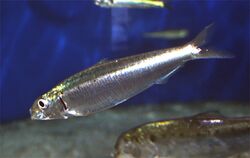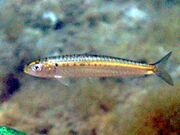Biology:European pilchard
| European pilchard | |
|---|---|

| |

| |
| Scientific classification | |
| Domain: | Eukaryota |
| Kingdom: | Animalia |
| Phylum: | Chordata |
| Class: | Actinopterygii |
| Order: | Clupeiformes |
| Family: | Alosidae |
| Genus: | Sardina Antipa, 1904 |
| Species: | S. pilchardus
|
| Binomial name | |
| Sardina pilchardus (Walbaum, 1792)[2]
| |
| Synonyms | |
| |
The European pilchard (Sardina pilchardus) is a species of ray-finned fish in the monotypic genus Sardina. The young of the species are among the many fish that are sometimes called sardines.[3][4] This common species is found in the northeast Atlantic, the Mediterranean, and the Black Sea at depths of 10–100 m (33–328 ft).[1] It reaches up to 27.5 cm (10.8 in) in length and mostly feeds on planktonic crustaceans.[2] This schooling species is a batch spawner where each female lays 50,000–60,000 eggs.[2]
Description
The European pilchard is a small to medium-sized, somewhat elongated, herring-like fish. The origin of the pelvic fins is well behind that of the dorsal fin, and the last two soft rays on the anal fin are larger than the remainder. The upper parts are green or olive, the flanks are golden and the belly is silvery.[3]
Distribution and habitat
The European pilchard occurs in the northeastern Atlantic Ocean, the Mediterranean Sea and the Black Sea. Its range extends from Iceland and the southern part of Norway and Sweden southwards to Senegal in West Africa. In the Mediterranean Sea it is common in the western half and the Adriatic Sea, but uncommon in the eastern half and the Black Sea.[5] It is a migratory, schooling, largely coastal species but sometimes travels as far as 100 km (62 mi) out to sea. During the day it is mostly in the depth range 25 to 55 m (80 to 180 ft) but can go as deep as 100 m (330 ft). At night it is generally from 10 to 35 m (33 to 115 ft) beneath the surface.[1]
Ecology
In the Mediterranean, the European pilchard moves offshore in the autumn, preferring the deeper cooler waters and constant salinity out at sea to the variable temperatures and salinities of inshore waters. Spawning starts to take place in winter, and in early spring, juveniles, larvae and some adults move towards the coast, while other adults migrate inshore later in the year. Multiple batches of eggs are produced over a long breeding period, total fecundity being 50,000 to 60,000. Most juveniles become sexually mature at about a year old and a length of 13 to 14 cm (5.1 to 5.5 in); pilchards are fully grown at about 21 cm (8.3 in) when aged about eight years.[6]
The diet consists of both zooplankton and phytoplankton. The zooplankton is largely copepods and their larvae, which make daily vertical migrations to feed near the surface at night, and this is when the adult pilchards feed on them; juveniles feed during the day as well.[6] Along with the European anchovy (Engraulis encrasicolus), the European pilchard plays an important intermediate role in the Mediterranean ecosystem as a consumer of plankton and as a food for larger demersal predators such as the European hake (Merluccius merluccius) and the European conger eel (Conger conger). This role is particularly noticeable in the Adriatic Sea where the water is shallow, the food chain is shorter and energy is retained within the basin; overfishing of pilchard and anchovy can thus cause dramatic changes in the ecosystem.[6]
Fisheries and uses
There are important fisheries for this species in most of its range. It is mainly caught with purse seines and lampara nets, but other methods are also used including bottom trawling with high opening nets. In total, around a million tonnes are taken annually, with Morocco, Portugal and Spain having the largest catches. The Food and Agriculture Organization (FAO) considers the Moroccan fishery overfished.[5]
The adults may be sold as pilchards; the juveniles, as sardines.[3] The terms "sardine" and "pilchard" are not precise, and what is meant depends on the region. The United Kingdom's Sea Fish Industry Authority, for example, classifies sardines as young pilchards.[7] One criterion suggests fish shorter in length than 15 cm (6 in) are sardines, and larger fish are pilchards.[8] The FAO/WHO Codex standard for canned sardines cites 21 species that may be classed as sardines.[4]
The fish is sold fresh, frozen or canned, or is salted and smoked or dried; as the flesh is of low value, some of the catch is used for fishing bait or fertilizer and some is manufactured into fish meal.[1]
See also
References
- ↑ 1.0 1.1 1.2 1.3 Tous, P.; Sidibé, A.; Mbye, E.; de Morais, L.; Camara, Y.H.; Adeofe, T.A.; Munroe, T.; Camara, K. et al. (2015). "Sardina pilchardus". IUCN Red List of Threatened Species 2015: e.T198580A15542481. doi:10.2305/IUCN.UK.2015-4.RLTS.T198580A15542481.en. https://www.iucnredlist.org/species/198580/15542481. Retrieved 12 November 2021.
- ↑ 2.0 2.1 2.2 Froese, Rainer and Pauly, Daniel, eds. (2006). "Sardina pilchardus" in FishBase. April 2006 version.
- ↑ 3.0 3.1 3.2 "European pilchard (Sardina pilchardus)". Fishes of the NE Atlantic and the Mediterranean. Marine Species Identification Portal. http://species-identification.org/species.php?species_group=fnam&id=1237.
- ↑ 4.0 4.1 "Codex standard for canned sardines and sardine-type products codex stan 94 –1981 REV. 1–1995". Codex Alimentarius. FAO/WHO Codex Alimentarius Commission. pp. 1–7. http://www.codexalimentarius.net/download/standards/108/CXS_094e.pdf.
- ↑ 5.0 5.1 "Sardina pilchardus (Walbaum, 1792)". Species Fact Sheet. FAO. http://www.fao.org/fishery/species/2910/en.
- ↑ 6.0 6.1 6.2 Gibson, R.N.; Atkinson, R.J.A.; Gordon, J.D.M. (2016). Oceanography and Marine Biology: An Annual Review. CRC Press. pp. 209–226. ISBN 978-1-4200-9422-0. https://books.google.com/books?id=PDlCjy30WKkC&pg=PA209.
- ↑ "FAQs". Seafish. http://www.seafish.org/resources/details.asp?id=238&i=13.
- ↑ Stummer, Robin (17 August 2003). "Who are you calling pilchard? It's 'Cornish sardine' to you...". The Independent. https://www.independent.co.uk/news/uk/home-news/who-are-you-calling-pilchard-its-cornish-sardine-to-you-536136.html.
Wikidata ☰ Q208600 entry
 |





